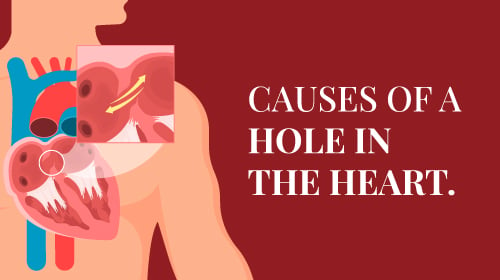Hole in the Heart – Symptoms, Causes & Treatment
February 17, 2025

A normal heart is divided into two sides, the left and right, separated by a septum. The right side of the heart receives blood low in oxygen and sends it toward the lungs. Reloaded with oxygen, the blood returns from the lungs and empties into the left side of the heart. The septum averts the mixing of blood between the two sides.
Withal, some babies are born with a hole in the heart septum at the upper or lower walls. A hole in the septum dividing the upper left and right heart chambers is known as an Atrial Septal Defect (ASD), and a septum hole in the lower sections is known as a Ventricular Septal Defect (VSD). In addition, raising awareness about heart attack symptoms in men and women may lower the occurrence of heart attacks and, as a whole, heart disease.
Types
What are ASD and VSD?
An Atrial congenital heart defect (ASD) is a hole in the wall between the heart’s two upper chambers. ASD is a congenital condition present in a person since birth. A Ventricular septal defect (VSD) could be a hole in the wall between the two lower chambers. In ASD and VSD, purified blood in the left chamber mixes with oxygen-deficient blood on the right side. A large hole in ASD can cause the lungs to overfill with blood and make the heart work harder.
VSD in Adults
VSD cases are relatively rare in adults, more severe, and potentially fatal. The most common cause is damage to the heart muscle, causing a hole after a severe heart attack. The other reasons are heart surgeries and trauma to the heart. This sort of defect usually needs surgery.
VSD in Infants
A VSD in infants is a congenital abnormality (one that the baby is born with) and occurs because of abnormal organ development during pregnancy. Babies born with a VSD and other associated heart conditions are much more severe and require corrective surgery. Babies born with either a small VSD or an isolated finding usually have a better outcome. Many of them can live everyday lives without realizing a problem. The VSD is generally picked up by a doctor when a patient visits for some other condition.
Symptoms
A tiny hole in the heart may not cause any issues. However, a large hole is typically diagnosed soon after birth because it causes symptoms. Most ventricular septal defects are diagnosed by pediatricians when they examine newborns. ASDs can be more difficult to diagnose because they don’t always have easy signs to look for.
Septal Defects in Babies Include
- Abnormal heartbeat
- Fast breathing
- Poor growth
- Trouble eating
In Older Children and Adults,
- Fatigue
- Heart palpitations
- Inability to exercise
- Shortness of breath
- Stroke
Causes
Genetics
A child could also be at higher risk of congenital heart defects if either parent had a congenital heart defect. The presence of other genetic disorders: Children with other genetic disorders, like Down syndrome, can have a hole in the heart.
Smoking
Babies born to mothers who smoked during pregnancy are prone to congenital heart defects like ASD and VSD.
Risk Factors
The development of a hole in the heart is often influenced by genetic and environmental factors. Some key risk factors include:
- Genetic predisposition: A family history of congenital heart defects may increase the likelihood of a hole in the heart.
- Maternal health conditions: Pregnancy complications like diabetes, lupus, and rubella (German measles) can increase the likelihood of a congenital heart defect in the baby.
- Substance exposure during pregnancy: Alcohol, tobacco, and certain medications (like those for high blood pressure, lupus, or seizures) can increase the chances of a baby being born with a heart defect.
- Environmental factors: During pregnancy, exposure to harmful substances like thalidomide, isotretinoin, or statins can affect the development of the baby’s heart.
Complications
The complications of a hole in the heart vary depending on the size and kind of defect present. Potential complications include:
- Atrial Septal Defect (ASD): A Large ASD can lead to right-sided heart failure, arrhythmias, stroke, pulmonary hypertension, and Eisenmenger syndrome.
- Ventricular Septal Defect (VSD): May cause heart infection, aortic valve leakage, and heart failure.
- Pregnancy Complications: Women with ASD may face high-risk pregnancies and should consult a healthcare provider before pregnancy.
When to Seek Medical Care?
Any of the subsequent symptoms should be reported to your child’s healthcare provider:
- Unusual weight gain in the first months of life
- Unusual behaviour
- Shortness of breath
- Bluish colour of the skin, lips, or under the nails
- Unusual or unexplained sweating
- Hole in the Heart- Diagnosis & Treatment
- Physical exam- The doctor checks and listens to the heart and lungs with a stethoscope for a heart murmur
- Echocardiography
- Electrocardiogram
- Chest x-ray
- Cardiac catheterization
- Pulse oximetry
Available Diagnostic Procedures
An echocardiogram can confirm the presence of a hole in the heart. This painless test uses ultrasound waves to construct a movie of the heart. It can quantify the size of the left-to-right shunt by enlargement of the left ventricle and pressure in the lungs, and estimate the degree of shunting by an empirical formula.
A chest X-ray is helpful to see whether the overall heart size is enlarged and may demonstrate evidence of fluid in the lungs or pulmonary congestion. In addition, an electrocardiogram is beneficial to evaluate the left and right ventricular dimensions. If right ventricular hypertrophy is stipulated, this may suggest pulmonary hypertension.
Cardiac catheterization may be performed in certain circumstances. A skinny plastic tube called a catheter is inserted into the skin in the groin, arm, or neck under local anesthesia.
Pressures are measured inside the heart, particularly if any concern was previously raised over the degree of pulmonary hypertension and, therefore, operability.
If additional abnormalities are possible, a dye study may be performed to visualise the anatomy inside the heart. But the echocardiogram may achieve this goal in the majority of patients.
Post Surgery – Follow-Up
Regular full-body checkups and echocardiograms are required to reassess the ventricular septal defect continually.
Prevention
Although prevention of congenital heart defects like holes in the heart may not be fully possible, there are steps that can help reduce the risk:
- Prenatal care: Early and proper prenatal care is essential. It helps manage conditions such as diabetes or lupus that can increase the risk of heart defects in the baby.
- Vaccination: Make sure to get vaccinated against rubella before pregnancy to lower the chances of birth defects associated with the virus.
- Healthy lifestyle: Avoid exposure to harmful substances during pregnancy, including tobacco, alcohol, and certain medications.
- Family history: If there is a family history of congenital heart defects, genetic counseling can help assess risks and guide preventive measures.
- Medication review: If you have preexisting conditions like diabetes or lupus, work with your healthcare provider to manage them carefully during pregnancy to minimize the risk of heart defects.
Frequently Asked Questions
1. Can a hole in the heart be cured?
There are no known medications that can cure the hole. If a child is diagnosed with an atrial septal defect, the healthcare provider may want to monitor it for a while to see if the hole closes on its own. During this period, a doctor might treat symptoms with medicine.







